In today’s fast-paced world, the demands of modern life often lead to various health issues, including lower back pain and stiff shoulders. Whether you’re an office worker spending long hours at a desk, an athlete pushing your body to the limits, or simply someone dealing with the natural effects of aging, these issues can be both uncomfortable and disruptive to daily life. However, there is hope. Mobility exercises can be a powerful tool in your arsenal to combat and alleviate these common problems. In this comprehensive guide, we will delve into the world of mobility exercises, exploring their benefits, specific exercises to target lower back pain and stiff shoulders, and how to incorporate them into your daily routine.
The Importance of Mobility
Mobility refers to your body’s ability to move freely and easily through its full range of motion. It’s a crucial component of physical health, influencing everything from your posture to your athletic performance. Mobility exercises are designed to improve this range of motion by increasing flexibility, reducing muscle tightness, and enhancing joint stability. By focusing on mobility, you can not only alleviate common issues like lower back pain and stiff shoulders but also enhance your overall quality of life.
Lower Back Pain: Causes and Solutions
Lower back pain is one of the most prevalent health complaints globally. Whether caused by poor posture, sedentary lifestyles, or underlying medical conditions, it can significantly impact daily functioning. Fortunately, specific mobility exercises can help address lower back pain:
Cat-Cow Stretch
- How to do it: Start on your hands and knees, with your wrists directly under your shoulders and your knees under your hips. Inhale as you arch your back (the “cow” position), and exhale as you round your spine upward (the “cat” position). Repeat this motion for 10-15 breaths.
- Benefits: The cat-cow stretch gently mobilizes your spine, relieving tension in the lower back and improving flexibility.
Child’s Pose
- How to do it: Begin on your hands and knees, then sit back onto your heels, reaching your arms forward. Hold for 30 seconds to 1 minute.
- Benefits: Child’s pose stretches and relaxes the lower back muscles, providing relief from discomfort.
Hip Flexor Stretch
- How to do it: Kneel on one knee with the other foot in front, creating a 90-degree angle with your front leg. Gently push your hips forward until you feel a stretch in the front of your hip. Hold for 30 seconds on each side.
- Benefits: Tight hip flexors can contribute to lower back pain. This stretch helps to release tension in these muscles.
Stiff Shoulders: Causes and Solutions
Stiff shoulders can result from various factors, such as poor posture, overuse, or muscle imbalances. Mobility exercises can help you regain full shoulder mobility and alleviate discomfort:
Shoulder Rolls
- How to do it: Stand with your feet shoulder-width apart. Roll your shoulders backward in a circular motion for 10-15 seconds, then reverse the direction.
- Benefits: Shoulder rolls promote blood flow and relieve tension in the shoulder area.
Wall Angels
- How to do it: Stand with your back against a wall, feet about six inches away. Raise your arms, keeping them in contact with the wall, and slowly slide them up and down. Perform 10-15 repetitions.
- Benefits: Wall angels improve shoulder mobility and posture by strengthening the muscles around the shoulder blades.
Doorway Stretch
- How to do it: Stand in a doorway with your arms at shoulder height and your elbows bent at 90 degrees. Place your palms and forearms against the doorframe. Lean forward gently until you feel a stretch across your chest. Hold for 30 seconds.
- Benefits: This stretch opens up the chest and shoulders, counteracting the effects of hunching over a computer or desk.
Incorporating Mobility Exercises into Your Routine
To experience the full benefits of mobility exercises, consistency is key. Here are some tips on incorporating these exercises into your daily routine:
- Start Slowly: If you’re new to mobility exercises, begin with a few basic movements and gradually increase intensity and duration.
- Set a Schedule: Dedicate specific times in your day for mobility exercises. This can be in the morning to energize your body or in the evening to unwind.
- Mix it Up: Variety is essential. Rotate through different exercises to target various muscle groups and maintain your interest.
- Listen to Your Body: Pay attention to how your body responds to these exercises. Discomfort is normal, but sharp pain is not. If an exercise causes pain, stop immediately and consult a healthcare professional.
- Combine with Strength Training: Incorporate mobility exercises into your warm-up and cool-down routines when engaging in strength training or other workouts.
- Consider Professional Guidance: If you have specific issues or injuries, consider working with a physical therapist or mobility specialist who can create a customized exercise plan.
Conclusion
Lower back pain and stiff shoulders are common issues that can significantly impact your daily life. However, with a consistent mobility exercise routine, you can alleviate these problems and improve your overall quality of life. Whether you’re dealing with the demands of a sedentary job or looking to enhance your athletic performance, mobility exercises are a powerful tool to keep you moving freely and feeling your best. So, roll out that yoga mat, stand up from your desk, and start incorporating these exercises into your daily routine. Your body will thank you, and you’ll be well on your way to a healthier, more mobile you.
13 Top Exercises and Stretches for Lower Back Pain
1. Knee to Chest
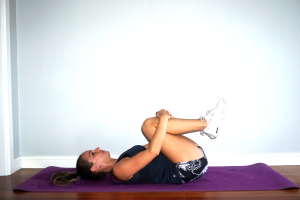
Laying on your back, gently pull your knees to your chest, holding for a second, then extending your arms back out straight. Hold for 20 seconds, repeat 5 repetitions, perform 3 times per day.
2. Knee Rotation
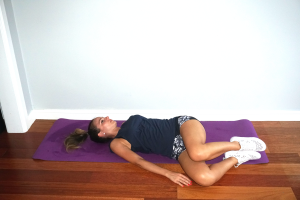
With your feet on the ground, bend your knees and gently move them from side to side in a windscreen wiper motion. This exercise for lower back pain works by gently rotating your lumbar spine. Rotate to each side 10 times. Perform 3 times per day.
3. Extensions

Laying on your stomach, gently press up and extend your lower back. Do not hold this, but repeat the movement 10 times, for 3 sets, three times per day. If this stretch feels too strong you can adjust it by resting on your forearms.
4. Lower back rotation
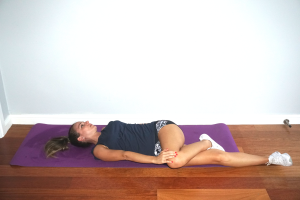
Tuck one foot behind the other knee, then gently pull your leg across. Hold the stretch for 20 seconds, repeat 5 times each leg, and perform 3 times per day.
5. Cat/Cow
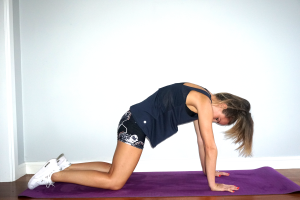
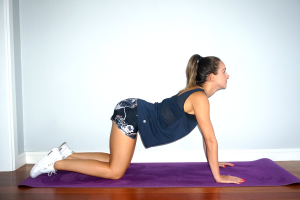
Start on your hands and knees, gently curve and flatten your mid back 20 times.
6. Child’s Pose
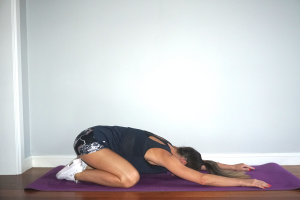
Start with your knees apart and toes touching. Reach out in front of you and sit your bum back towards your heels. Hold this pose for 30 seconds, repeat 5 times.
7. Foam rolling
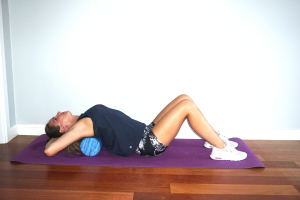
Foam rolling can be great part of exercises for lower back pain. Place the foam roller under your mid back, keep your backside on the ground, gently extend your spine backward. Hold for 30 seconds at a time.
8. Pelvic Tilts
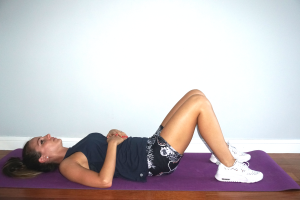
Laying on your back, arch your lower back, then flatten it into the ground. Perform this 30 times.
9. Spiky ball roll on glutes
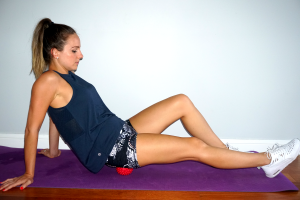
Use a spiky ball to roll out tight muscles in your buttock. Roll the ball around the fleshy part of your buttock for 30 – 60 seconds at a time.
10. Hip flexor stretches
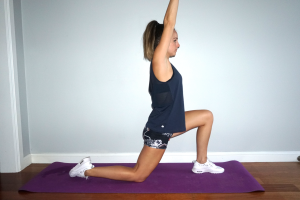
This will stretch out the front of your hip, hold the stretch for 30 seconds, repeat 5 times each leg.
11. Piriformis stretches

This is a strong stretch for your backside, place your leg across over onto your other thigh in a figure four shape, and gently lower your buttock to the ground. Hold for 20 seconds. Repeat each leg 5 times.
12. Thread the needle
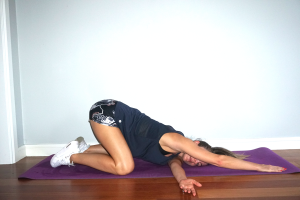
In a similar position to downward dog but on your knees, reach your arm through to give your mid-back a stretch. Hold for 30 seconds. Repeat 5 times each side.
13. Hamstring stretches
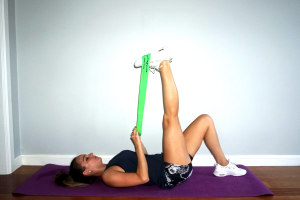
Lay on your back, with one leg bent and one leg in the air with a stretch band around your foot. Hold for 30 seconds, repeat both legs 5 times.
Conclusion
Whilst these exercises for lower back pain should help it’s important to understand why the pain is occurring in the first place.
A physiotherapist will help determine the root cause of the problem and set out a specific program tailored to your needs to ensure you get the best outcomes for you.
Back pain can easily be put down to the ageing process and although there is some truth to that, the amount of stiffness you feel does not have to relate to how old you are.
As you age, the fluid that lubricates joints decreases, cartilage thins and muscles tighten, however there can be other factors at play when it comes to back pain and stiffness.



